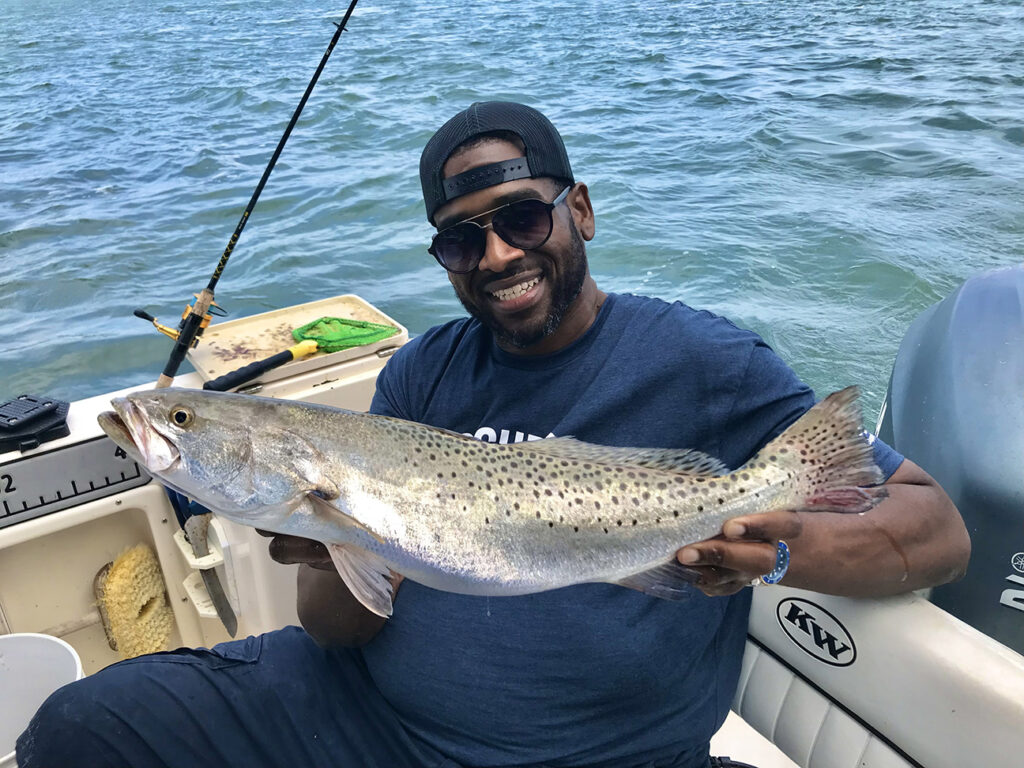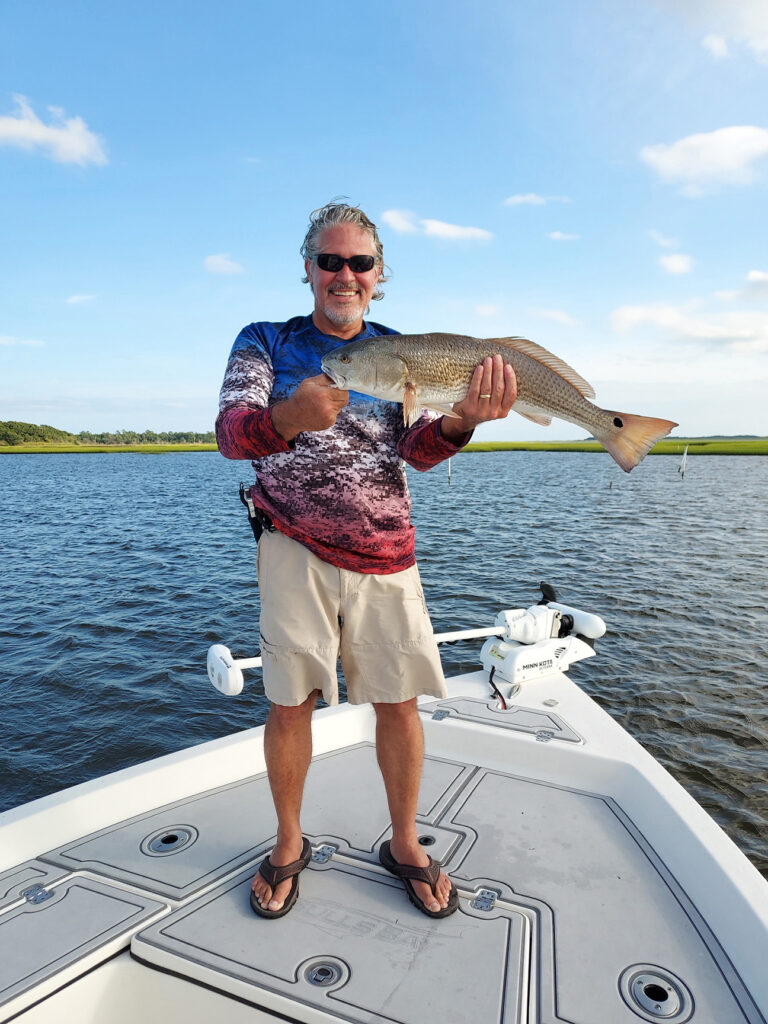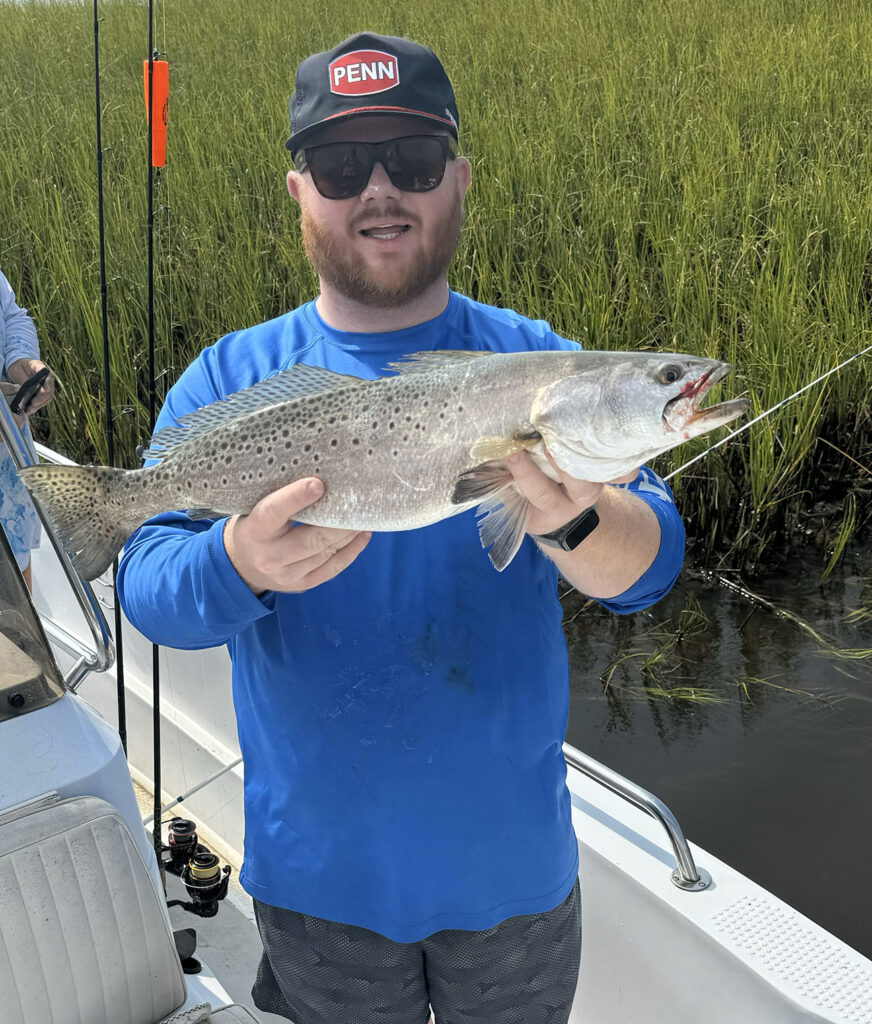Swansboro/Emerald Isle – October 2024
Morgan, of The Reel Outdoors, reports that when water conditions are clean, anglers are seeing spanish mackerel and a lot of bluefish, both along the surf and around the pier.
Bottom fishing from the surf has included catches of croaker, spots, and puppy drum. Some pompano are also included in the bottom fishing action.
Back in the sound, anglers are catching a bunch of puppy drum and really big croakers.
The nearshore action is starting to come alive, with anglers catching false albacore, spanish mackerel, and bluefish.
King mackerel are around, though the bite is still spotty as the area awaits the fall run.
Offshore trolling action has been all about wahoo, and this will continue to be the story moving through October.
The deeper bottom areas are holding a bunch of triggerfish and black sea bass.
Rob, of Sandbar Safari Charters, reports that speckled trout fishing has been good in the ICW and deeper inlet channels during rising tide cycles. On the falling tide, anglers are having better successes back up in the mainland rivers and creeks. Live finger mullet or shrimp rigged on jig heads worked through channel cuts or other areas of current have been a deadly combo. Those looking to fish artificials are having success with Zoom fluke soft plastics, especially when fishing closer to the sound (where there are a lot of glass minnows).
Red drum action has been good near the inlets and out along the surf. Live or cut mullet is the best option for them.
A lot of big bluefish are out along the beaches and just inside the inlets. Any hard plugs, especially those in white color patterns, almost certainly will produce strikes.
Black drum have started to show back up in better numbers around oyster points and channels throughout the marshes. With “trash fish” species becoming less common, live shrimp under popping corks has been the best for targeting them.
As the nearshore waters clean, bigger spanish mackerel and some king mackerel should show up on the reefs.

James Chaney, of Raleigh, hooked this 24.5″ trout near Swansboro using a live menhaden. He was fishing with Capt. Lee Winkleman of Top Gun Fishing Charters.
Matt, of Friendly City Fishing Charters, reports that speckled trout action has really started to kick off. With all the rain water in the system, anglers should spend more time focusing on the marsh areas, as the trout, in particular, will seek cleaner conditions closer to the inlet to feed.
Bait also starts to push out of the rivers when there is that influx of freshwater. With this moving bait, the red drum get fired up. The redfish are scattered just about everywhere, from channels and bays throughout the marsh to docks and grass banks along the ICW.
Black drum are another species that doesn’t get enough credit. These fish are hardly affected by changes in water conditions and will be staged right over their same structures or shell bottoms.
Jacob, of Southern Tides Fishing Charters, reports that speckled trout fishing has started to get good. Anglers have been doing best by targeting deeper channels closer to the inlet, especially areas where there is some good moving current. Most of these fish are in the 2-3 lb. range and striking live shrimp under corks. For the best results, set baits to be drifting just a couple inches off the bottom.
This same live shrimp and cork setup will also produce black drum when fishing deeper holes.
The red drum action has been steady, with anglers having success using live mullet on Carolina rigs. Target marsh bays on incoming tides, and then focus on docks as the tide falls out.
Flounder are everywhere, and they’re hitting both live mullet and shrimp.
Spanish mackerel have made a better showing nearshore, and a lot of bluefish are around the inlet.
John, of Early Riser Fishing Charters, reports that anglers have found that the speckled trout action has really started to pick up in the river. Anglers are getting them on topwater plugs, as that reaction strike is the best tactic with so much live bait around. The trout bite has been best both early and late in the day. For anglers fishing in-between times, live shrimp can produce bites. Anglers are finding most of the trout positioned around points and on shell structure close to creek mouths.
Nearshore action is starting to see king mackerel moving closer to the beach, as anglers have been finding some quality fish inside three miles. Live bait is definitely the bait of choice.
Historically, a few sailfish show up this time of year within that same three-mile range.
When off the beach, keep a couple of smaller spinning rods ready to cast to larger spanish mackerel and false albacore. Both species should respond to small diamond jigs.

Bob Messig, of Emerald Isle, landed this 27.5″ red drum in the backwaters of Swansboro using a live finger mullet. He was fishing with Clyde Yancey.
Lee, of Top Gun Fishing, reports that a run of false albacore has been happening off the beaches. Anglers are getting in on this action by casting 1 oz. metal jigs to surface-feeding frenzies.
Some larger spanish mackerel are mixed in, with fish up to 5 lbs. around.
Anglers out at the nearshore reefs are seeing gray trout showing up in strong numbers. The best tactic is jigging 2 oz. Blue Water Candy Thingamajigs or dropping down live mullet.
Offshore bottom fishing remains strong, with limits of vermilion snapper and triggerfish when targeting live bottom in the 100-150’ range.
Wahoo have made a strong showing in the 200-300’ area.
Mike, of Bogue Inlet Pier, reports that the action for anglers looking to cast plugs has really fired up now that water temperatures on the beach have cooled. Pier anglers have been enjoying catches of spanish mackerel, false albacore, and bluefish.
Some ribbonfish are also in the mix.
A few smaller king mackerel (to 17 lbs.) have started showing up.
Bottom fishing has produced a few puppy drum (to 7 lbs.), pompano, and blowtoads.

